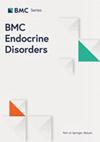血糖控制下 1 型糖尿病患者的血脂变化和生物标志物鉴定
IF 2.8
3区 医学
Q3 ENDOCRINOLOGY & METABOLISM
引用次数: 0
摘要
众所周知,1 型糖尿病(T1DM)会引发脂质代谢紊乱。本研究旨在比较 T1DM 患者在血糖得到控制后的血脂变化,并探索其潜在机制。此外,我们还试图找出在血糖控制条件下与 T1DM 相关的新型血脂生物标志物。我们共招募了 27 名血糖控制超过一年的 T1DM 成人患者(年龄:34.3 ± 11.2 岁)和 24 名健康对照者(年龄:35.1 + 5.56 岁)。我们对所有参与者的临床特征进行了分析,并收集了血浆样本,利用质谱法进行非靶向脂质体分析。我们确定了 13 大类 594 种脂质。对血浆脂质谱的差异分析表明,在血糖水平得到控制的 T1DM 患者中,脂质水平普遍下降,其中甘油三酯 (TAG) 和甘油二酯 (DAG) 明显下降。此外,这些 T1DM 患者的六种磷脂酰胆碱 (PC) 和三种磷脂酰乙醇胺 (PE) 水平也较低。随机森林分析确定 DAG(14:0/20:0)和 PC(18:0/20:3)是血糖控制下 T1DM 最显著的血浆标记物(AUC = 0.966)。在血糖控制下,T1DM 患者 13 类脂质中所有代谢物的水平都发生了变化,其中 TAGs、DAGs、PCs、PEs 和 FFAs 的下降最为显著。这项研究发现,DAG(14:0/20:0)和 PC(18:0/20:3)是血糖得到控制的 T1DM 患者的有效血浆生物标志物。本文章由计算机程序翻译,如有差异,请以英文原文为准。
Lipid profile alterations and biomarker identification in type 1 diabetes mellitus patients under glycemic control
Type 1 diabetes mellitus (T1DM) is well-known to trigger a disruption of lipid metabolism. This study aimed to compare lipid profile changes in T1DM patients after achieving glucose control and explore the underlying mechanisms. In addition, we seek to identify novel lipid biomarkers associated with T1DM under conditions of glycemic control. A total of 27 adults with T1DM (age: 34.3 ± 11.2 yrs) who had maintained glucose control for over a year, and 24 healthy controls (age: 35.1 + 5.56 yrs) were recruited. Clinical characteristics of all participants were analyzed and plasma samples were collected for untargeted lipidomic analysis using mass spectrometry. We identified 594 lipid species from 13 major classes. Differential analysis of plasma lipid profiles revealed a general decline in lipid levels in T1DM patients with controlled glycemic levels, including a notable decrease in triglycerides (TAGs) and diglycerides (DAGs). Moreover, these T1DM patients exhibited lower levels of six phosphatidylcholines (PCs) and three phosphatidylethanolamines (PEs). Random forest analysis determined DAG(14:0/20:0) and PC(18:0/20:3) to be the most prominent plasma markers of T1DM under glycemic control (AUC = 0.966). The levels of all metabolites from the 13 lipid classes were changed in T1DM patients under glycemic control, with TAGs, DAGs, PCs, PEs, and FFAs demonstrating the most significant decrease. This research identified DAG(14:0/20:0) and PC(18:0/20:3) as effective plasma biomarkers in T1DM patients with controled glycemic levels.
求助全文
通过发布文献求助,成功后即可免费获取论文全文。
去求助
来源期刊

BMC Endocrine Disorders
ENDOCRINOLOGY & METABOLISM-
CiteScore
4.40
自引率
0.00%
发文量
280
审稿时长
>12 weeks
期刊介绍:
BMC Endocrine Disorders is an open access, peer-reviewed journal that considers articles on all aspects of the prevention, diagnosis and management of endocrine disorders, as well as related molecular genetics, pathophysiology, and epidemiology.
 求助内容:
求助内容: 应助结果提醒方式:
应助结果提醒方式:


